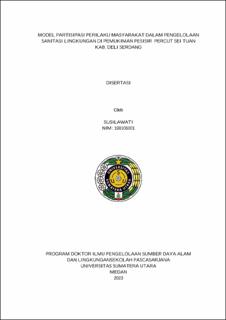| dc.description.abstract | The level of community participation in the execution of environmental sanitation management initiatives remains a challenge, particularly in coastal areas. It is crucial to involve community engagement so that people feel they own and are accountable for every government program activity. Community engagement is crucial to the effectiveness of sanitation management in the Percut Sei Tuan coastal area, beginning with the planning, implementation, utilization, and maintenance of facilities and equipment. The method to altering sanitation behavior through the role of community engagement in sanitation management is not yet ideal, resulting in potential environmental degradation, social, and health consequences. This study aims to develop a model of community-based sanitation management in the coastal communities of Percut Sei Tuan, Deli Serdang Regency. Cross-sectional study is the type of quantitative research and research design employed. This study's sample comprised of 414 family heads from the seaside community of Percut Sei Tuan. The stages of the research included a condition analysis, a population factor analysis, an examination of socio-economic factors, culture, gender roles, facilities and infrastructure, and an analysis of stakeholder roles' influence. PLS Version 3.3's Structural Equation Model (SEM) software was utilized for data analysis in order to develop a model for community engagement in environmental sanitation management. Population (p-value = 0.344) and socioeconomic status (p-value = 0.754) were shown to be unrelated to behavior in the study's findings. Culture (p=0.000), gender role (p=0.000), facilities and infrastructure (p-value= 0.001), role of stakeholders (p-value=0.001), and behavior (p-value = 0.002) all strongly connected to community engagement. Behavior = 0.213 coastal culture + 0.200 gender roles; Community participation = 0.135 behavior + 0.159 infrastructure + 0.192 stakeholder roles. Based on the model of community participation in environmental sanitation management in the coastal settlement of Percut Sei Tuan, Deli Serdang Regency, North Sumatra, behavioral factors are a crucial component of sustainable community participation, which will have an effect on environmental sanitation management. To promote community engagement in activities, communication with the community, community empowerment relating to the economics, culture, and gender, and stakeholder support are required. | en_US |


